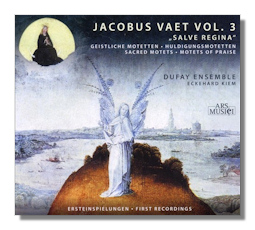
The Internet's Premier Classical Music Source
Related Links
- Vaet Reviews
- Latest Reviews
- More Reviews
-
By Composer
-
Collections
DVD & Blu-ray
Books
Concert Reviews
Articles/Interviews
Software
Audio
Search Amazon
Recommended Links
Site News
 CD Review
CD Review
Jacobus Vaet

Volume 3 - Salve Regina
- Angelus ad pastores ait for 6 Voices [GA III, 43]
- Ascendetis post filium for 6 Voices [GA III, 46]
- Qui gerit Augusti for 4 Voices [GA I, 15]
- Currite felices [GA III, 5]
- Aurea luce
- Beata es et venerabilis for 4 Voices [GA I, 4]
- Mater digna Dei for 5 Voices [GA II, 31]
- Salve Regina for 5 Voices [GA VI, 3]
- Vitam quae faciunt beatiorum for 6 Voices [GA III, 62]
The Dufay Ensemble/Eckehard Kiem
Ars Musici 232403
Here is Volume 3 in this little-bruited but immensely valuable series by the Dufay Ensemble under Eckehard Kiem on Ars Musici of the works of Jacobus Vaet, who lived from about 1529 to 1567. Classical Net has received the recent Volumes 1 and 2 very favorably.
The singing of this seven-person, all male, group – which was founded in the mid 1990s – has now grown even more acclimated to the idiom of Vaet in this their third set of items… a series of (sacred) motets. The composer stands up well when compared with his contemporaries, Palestrina (in Rome) and Lassus (Munich) – in quantity for sure; some would say in aspects of Vaet's execution of musical ideas and the liveliness and originality he brought to his creative settings as well. There is a freshness and drive in the dedication and seriousness with which Vaet marries music and text. The rich six-part texture of Angelus ad pastores ait (GA III, 43), for example, is exciting without being excitable. It's entirely fitting to the subject matter, exuberant and positive and persuasive in celebration of the liturgical significance of the piece. Vaet isn't in any way reticent, though, to project onto the joyousness of the occasion his own virtual, musical, gifts to the infant… the counterpoint, though restrained, is striking.
Not all the motets on this CD are strictly sacred: Ascendetis post fiemum (GA III, 46), Qui gerit Augusti (GA I, 15) and Currite felices (GA III, 5) were written in praise of the Habsburg court. Again, something of Vaet's personality emerges: intimacy and sense of color as well as somewhat insistent tonal centers suggest that Vaet, although writing to order, did so with his heart in the matter.
Aurea luce is perhaps the work which most consciously recalls Palestrina. Long cantabile lines woven both into (hence part of) and between (hence contrasting with) dense textures are not immediately a hallmark of the Franco-Flemish composer. Yet when he does employ them, they make more of an impact since the scale of singers employed by Vaet is more reduced and somewhat thinner. The The Dufay Ensemble conveys these proportions very well; their attention is at all times on the sonority of the texts, rather than "effect". Indeed, lack of pretention is a characteristic of the composer. In the Marian motet, Beata es et venerabilis (GA I, 4), for example, there is veneration; the act of adoration is implicit. But it is the singers' attention to the object of worship that gives the singing meaning. Technique, although present, never swamps communication. Similarly, the last three motets (two more Marian and one of only two settings by Vaet of classical texts – by Martial!) use conventional and otherwise unremarkable compositional methods.
At the end of this subdued yet enticing CD it's harder than ever to understand why Vaet should have been eclipsed when Lassus and Palestrina shone. There are still only these Ars Musici CDs in the current catalog devoted exclusively to Vaet's music. We're lucky that performers of the caliber of The Dufay Ensemble under Eckehard Kiem have undertaken to put that right. Their businesslike yet inspired style is totally in tune with the spirit and achievements of Vaet. This CD – and its companion, Volume 4, released at the same time and also reviewed – here – make compelling and very satisfying listening.
The acoustic of these 54 minutes worth of intense yet measured singing is close and resonant… the Klosterkirche at Oberried in the Black Forest. The liner notes in German, English and French are supplemented by the texts in Latin and German. The "Digipak" is as simply attractive as are those of the other releases so far in this series. If you've been collecting this series, volumes 1 and 2, you'll certainly want to snap this third one up immediately. There's no comparable selection available. If there were, it would be hard to imagine its making the simple yet memorable impact that does the justifiably acclaimed Dufay Ensemble.
Copyright © 2011, Mark Sealey.





















